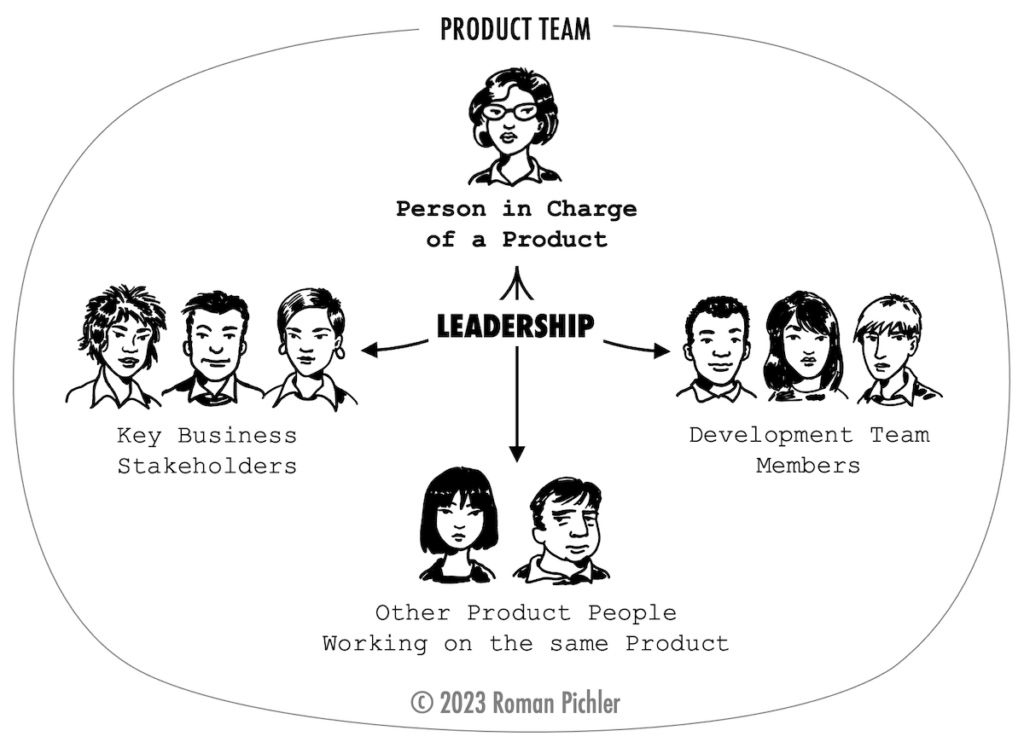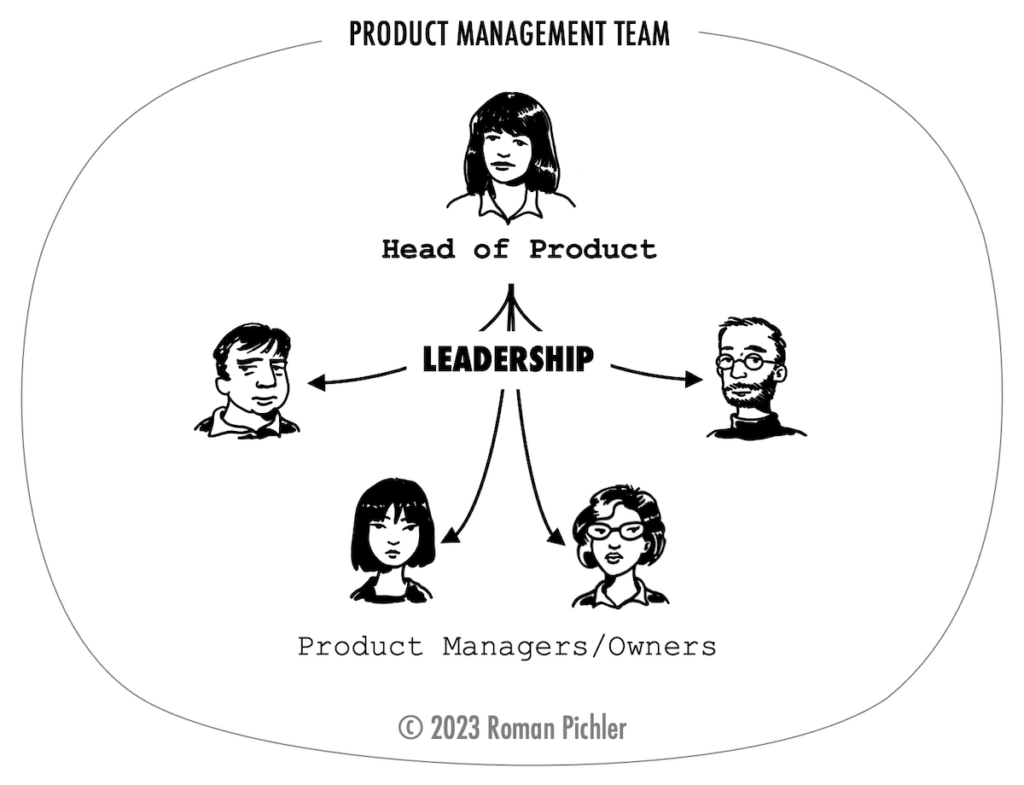Strong product leadership is crucial to offering successful products and enabling product-led growth. Unfortunately, there is disagreement and confusion about what exactly product leadership is and who should exercise it. Is product leadership limited to someone working as a head of product? Or can—and should—others lead in product management too? In this article, I share my advice to help you effectively practise product leadership and become great at leading others.
Listen to the audio version of this article:
Leading as the Person in Charge of the Product
When you hear the term leadership, you might first and foremost think of a senior manager like the head of product, Director of Product Management, VP of Product, or Chief Product Officer.[1] In fact, some people argue that product leadership can only be exercised by a management role. But in my mind, that’s a misunderstanding of what it means to lead. Leadership is present when an individual guides a group of people to achieve a desired outcome.
Leadership can therefore be exercised without being a boss. You don’t have to be a line manager to lead others. Consequently, a product manager and a Scrum product owner are leaders, too. They guide the stakeholders, development teams, and in the case of large products, other product people, to meet the agreed product goals, create the desired outcomes, and achieve product success, as Figure 1 shows.
The best product managers and product owners I have seen were great at aligning and guiding people. The opposite is also true: I’ve seen product people who were excellent at product management, had amazing market insights and great product ideas, but underachieved, as they lacked the right leadership skills.
Leading as the person in charge of the product, however, is far from being easy. As the individual is a peer and not the boss, they cannot tell people what to do and they are usually not in a position to offer rewards like a promotion. The leadership they exercise is called emergent or lateral leadership.[2] It does not derive from a position on the org chart. Instead, it must be earned. The followers—the product team members in Figure 1—must support the person in charge of the product and be willing to follow their lead. This is achieved by gaining the trust of the individuals: exhibiting the right expertise, showing empathy, speaking and acting with integrity, and being reliable and accountable, as I explain in more detail in the article Leading without Being the Boss and the video shown below.
Despite the necessity to practise emergent leadership, the person in charge of the product must be sufficiently empowered. This means that the individual has the final say on tactical and strategic product decisions if no agreement can be reached within the product team. If that’s not the case, leading the stakeholders and dev teams can feel like a Sisyphus job—you work very hard but achieve very little.
Leading as the Head of Product
A head of product is someone who manages a group of product people, individuals who look after a product or a product part—like an end-user-facing feature—and who might be called product managers or product owners. A head of product is responsible for developing the individuals and growing the product management team. This usually includes hiring people, coaching and supporting them, conducting performance reviews, offering promotions, and in some cases, terminating the employment contract, as I explain in more detail in the article What Should a Head of Product Do?. To put it differently, the head of product is the boss of the people on the product management team, and the team members report to the head.
The individual’s power consequently originates from their position. The leadership they exercise has been assigned or granted by the CEO or another executive. It is therefore called assigned leadership.[3]
But great heads of product do not rely on the power that comes with their role. They don’t exclusively practise assigned leadership, and they certainly don’t act as “product dictators.” Instead, they also take advantage of emergent leadership, as Figure 3 shows.
There are two reasons why effective heads practise emergent leadership. First, it helps them build strong, trustful connections with the product team members and create an environment of trust and support. This increases motivation, creativity, and productivity. To put it differently, it’s hard to innovate and have the courage to make and learn from mistakes if you don’t believe that your boss is supportive and understanding.
Second, succeeding as the head of product does not only require the ability to lead the people on the product management team. The individual also has to be able to influence the CEO and the other heads, like the heads of development, sales, and marketing, as Figure 3 shows. This is necessary, for example, to establish an effective product management function and to secure the necessary level of empowerment for the product people as well as to resolve cross-departmental issues—think of sales reps who routinely promise features to customers without first consulting the appropriate product managers.
Cultivating the Right Leadership Skills
As emergent leadership plays a key role in product management, it’s important to develop the skills that allow you to effectively exercise it. These include the following seven capabilities, which I teach in my Product Leadership Training and describe in my book How to Lead in Product Management:
- Trust-building: Be able to earn the trust of others, including senior stakeholders and managers, and use it to influence and guide people.
- Empathising: Understand other people’s feelings and needs and take the perspective of another person even if you dislike or disagree with them.
- Communication: Be able to effectively practise active listening and offer honest but constructive feedback to help people meet agreed goals.
- Goal setting: Determine the right outcomes and capture them in the right way. For example, to set product-related goals you might choose to use my goal-setting framework and my strategy and roadmap templates. Hold people accountable for meeting agreed goals.
- Collaborative decision-making: Leverage people’s collective expertise and secure their buy-in. Know when to delegate.
- Conflict resolution: Successfully address disagreements, resolve conflicts, and repair relationships.
- Self-leadership: Develop a growth mindset, effectively manage your time and energy levels, and look after yourself.
If you want to succeed at leading others, I strongly recommend that you develop these skills. To do so, attend my Product Leadership Training and read or listen to my book How to Lead in Product Management.
Notes
1. I follow Rich Mironov in viewing the four terms as synonyms.
2. See Peter G. Northouse, Leadership: Theory and Practice for more information on the term emergent leadership and see, for example, Tim Herbig, Lateral Leadership: A Practical Guide for Agile Product Managers for the use of the term lateral.
3. See Peter G. Northouse, Leadership: Theory and Practice. Assigned leadership is also called hierarchical leadership.




Post a Comment or Ask a Question